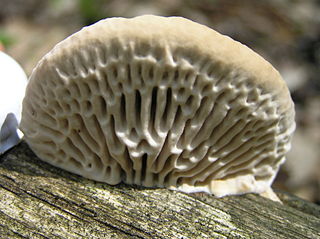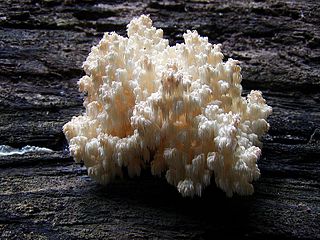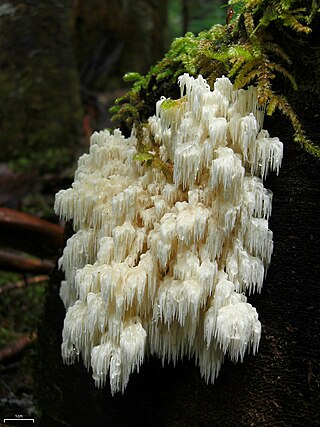
Hericium erinaceus is an edible mushroom belonging to the tooth fungus group. Native to North America, Europe, and Asia, it can be identified by its long spines, occurrence on hardwoods, and tendency to grow a single clump of dangling spines. The fruit bodies can be harvested for culinary use.
Abundisporus is a small genus of poroid fungi currently with seven recognized species. They differ from other polypores in having coloured rather than hyaline spores.

Gloeocystidiellum porosum is a plant pathogen. It is a corticioid homobasidiomycete that grows on various types of dead wood.

Daedalea is a genus of fungi in the family Fomitopsidaceae. The genus was circumscribed in 1801 by mycologist Christian Hendrik Persoon, based on the type D. quercina and four other species. The generic name is derived from the Ancient Greek δαιδαλεος.
Leif Randulff Ryvarden is a Norwegian mycologist.

Hericium is a genus of edible mushrooms in the family Hericiaceae. Species in this genus are white and fleshy and grow on dead or dying wood; fruiting bodies resemble a mass of fragile icicle-like spines that are suspended from either a branched supporting framework or from a tough, unbranched cushion of tissue. This distinctive structure has earned Hericium species a variety of common names—monkey's head, lion's mane, and bear's head are examples. Taxonomically, this genus was previously placed within the order Aphyllophorales, but recent molecular studies now place it in the Russulales.

Hypochnicium is a genus of corticioid fungi in the family Meruliaceae. The genus was circumscribed by mycologist John Eriksson in 1958.
Pirex is a fungal genus in the family Meruliaceae. It is a monotypic genus, containing the single crust fungus Pirex concentricus. It is found in the Pacific Northwest region of North America, where it causes a white rot in woody hardwood and conifer debris generated by timber harvesting.

The hydnoid fungi are a group of fungi in the Basidiomycota with basidiocarps producing spores on pendant, tooth-like or spine-like projections. They are colloquially called tooth fungi. Originally such fungi were referred to the genus Hydnum, but it is now known that not all hydnoid species are closely related.

Hericium abietis, commonly known as the bear's head or the western coral hedgehog, is an edible mushroom in the tooth fungus group. It grows on conifer stumps or logs in North America, producing a cream white fruit body up to 10–75 cm (4–30 in) tall and wide. It fruits from after the start of the fall rains to mid-season.

Por tu amor is a Mexican telenovela produced by Angelli Nesma Medina for Televisa in 1999. It aired on Canal de las Estrellas from May 31 to October 1, 1999. In the United States, it aired on Univision from May 8 to September 15, 2000.
Fomitiporia gabonensis is a fungus in the family Hymenochaetaceae. It was first isolated from Sub-Saharan Africa, specifically in the Guineo-Congolian forest. It has a pileate basidiome, small basidiospores and an absence of setae. Morphological features that differentiate this species with F. nobilissima and F. ivindoensis are its pileus' shape, pore surface color and diameter, as well as its ecology.
Fomitiporia ivindoensis is a fungus in the family Hymenochaetaceae. It was first isolated from Sub-Saharan Africa, specifically in the Guineo-Congolian forest. It has a pileate basidiome, small basidiospores and an absence of setae. Morphological features that differentiate this species with F. nobilissima and F. gabonensis are its pileus' shape, pore surface color and diameter, as well as its ecology.
Daedalea ryvardeniana is a neotropical species of poroid fungus in the family Fomitopsidaceae. Found in Brazil, it was described as new to science in 2012.

John Leonard Eriksson was a Swedish mycologist. He specialized in crust fungi of the basidiomycetes, collecting in Sweden, Finland and Canada.

Hericium cirrhatum is a saprotrophic fungus, commonly known as the tiered tooth fungus or spine face. The species is edible and good eating when young. It has a texture not unlike tender meat or fish. The flesh is cream in colour with an attractive smell when young, but it develops a very unpleasant odour in older specimens.

Hericium clathroides is a species of an edible fungus in the Hericiaceae family.

Hericium flagellum is a species of fungus in the family Hericiaceae native to Europe, first described by Giovanni Antonio Scopoli, and placed into its current genus by Christiaan Hendrik Persoon in 1797. It was confirmed—using sexual incompatibility studies—to be a distinct species from H. coralloides in 1983. Found in montane areas, typically on newly fallen trunks and stumps of fir, especially silver fir with one study finding over half of recorded specimens growing on silver fir deadwood in high conservation value areas. Spores are 5–6.5 by 4.5–5.5 µm.
Hericium bembedjaense is a species of fungus in the family Hericiaceae native to Cameroon, first described by Blaise Jumbam and Mary Catherine Aime in 2019, based on specimens from Dja Biosphere Reserve. It is found growing on Gilbertiodendron dewevrei and can be differentiated from other H. coralloides complex species by substrate and geographical range. It is the only Hericium species that has pleurocystidia.
Hericium bharengense is a species of fungus in the family Hericiaceae native to Sikkim in India, first described by K. Das, JA Stalpers & Ursula Ebelhardt in 2011. It can be distinguished from related species by "intricate" branching pattern of hymenophores, moderately long spines, size and ornamentation pattern of fruit bodies.











